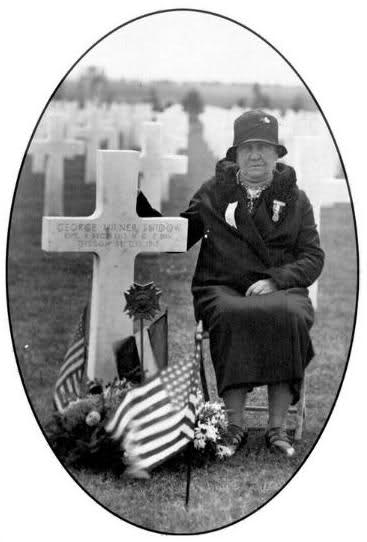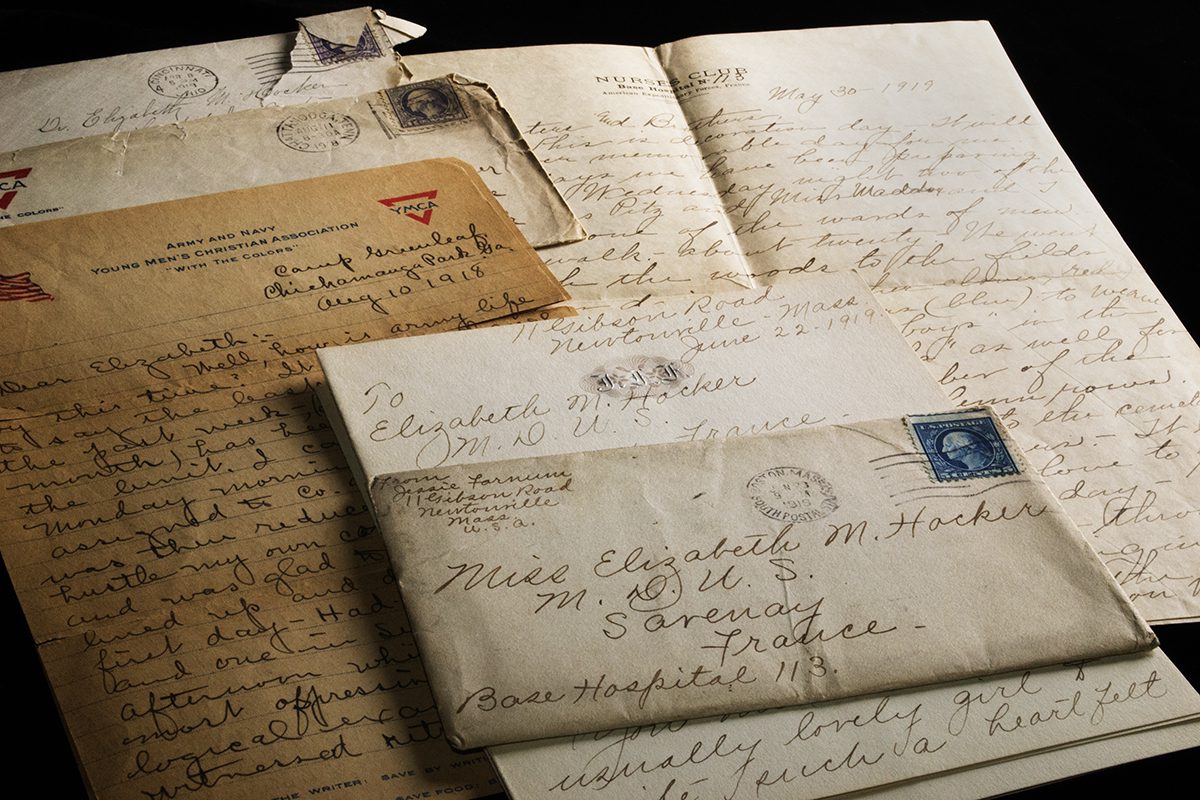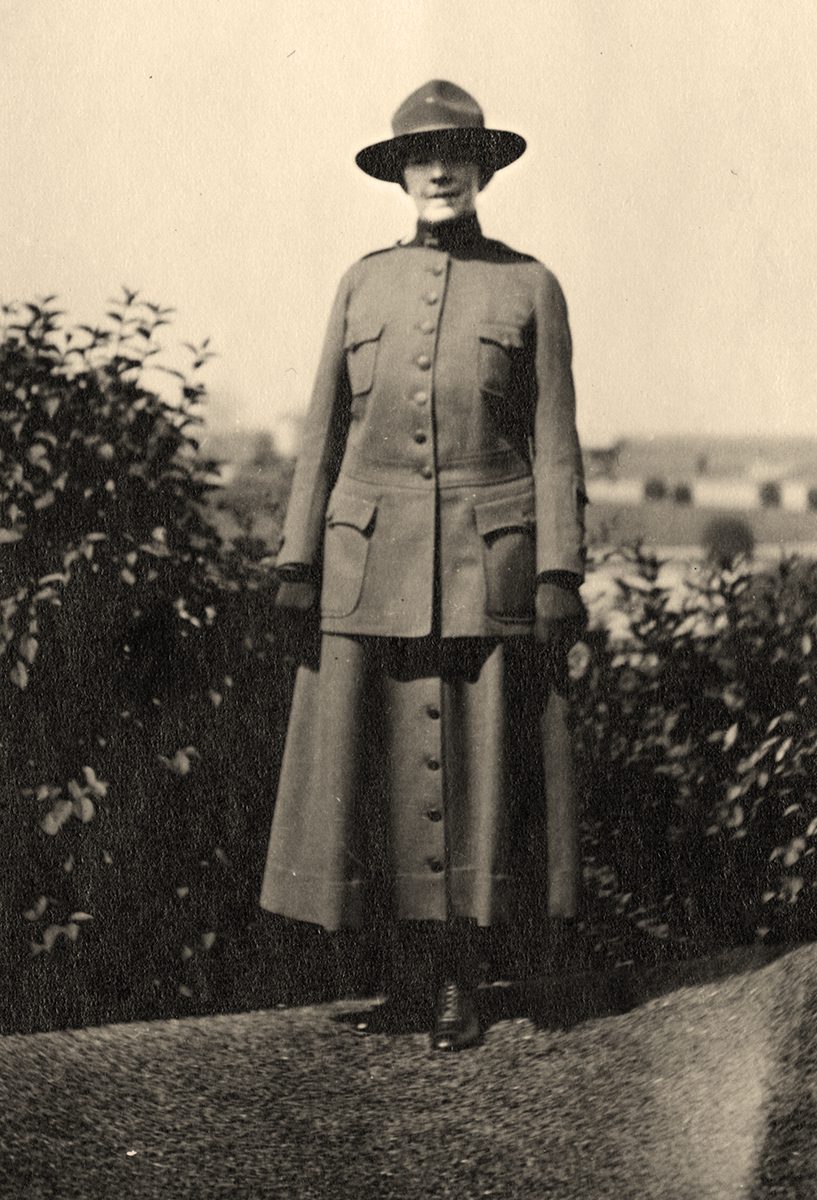Joanne Murray
Philadelphia, Pennsylvania, United States
 |
| American hospital cemetery in France, c. 1918; American Women’s Hospitals Collection, The Legacy Center, Drexel University College of Medicine. |
When the United States entered World War I in 1917, those in the U.S. Army Medical Department found themselves handling new types of wounds as a result of new methods of modern warfare. The staggering volume of war-related illness, complicated by the influenza pandemic, added to their challenges. These caregivers also found themselves becoming involved with the non-medical care of dying soldiers and the loved ones they left behind. End-of-life care required for so many and with so few to serve them, coupled with the concerns of distant families, created a new level of emphasis on emotional support. With an ocean between “our boys” and home, medical personnel began unexpectedly playing a significant role as surrogate family members and communicators. This type of caregiving was expanded for Americans because of distance – and an important related factor regarding beliefs surrounding death and how those ideas had been affected by the American Civil War.
In 1918, the Army Medical Department began allowing women physicians to enlist as contract surgeons. Fifty-six women took on this role, but only eleven served “over there.” Newly uncovered correspondence related to a rare woman contract surgeon, Dr. Elizabeth Hocker, documents the scope of caregiving for dying and dead soldiers provided by American medical personnel.1
Hocker served as an anesthetist in different care situations from base hospitals to surgical teams at the front. The relationships she developed with soldiers were more than merely that of physician and patient. Women health care personnel were expected to be a surrogate sister or mother to ill and wounded soldiers. An article in the May 1917 issue of the American Journal of Nursing states, “Fundamentally, the nursing spirit is most akin to the mother spirit, because it is from the mother’s instinct to protect and nourish and save life that the impulse to care for all weak and helpless human beings comes.”2 Hocker wrote that yet another “poor fellow when going under the anesthetic kept calling for his mother.”3Caregivers stepped into that role willingly, seeing it as part of their duties as healthcare personnel and fellow Americans. Some historians point to the sister/mother role as a protective device for women working far from home in a male-dominated and overwhelmingly male-occupied environment. This platonic, family-like caregiving was intended to send a message that female health care workers were not available for romantic or sexual encounters. But the stories of many nurses and this rare woman physician point to a genuine family feeling, as opposed to a professional guideline, and a desire to offer the kind of intense and personal emotional care that a mother or sister would. Hocker repeatedly noted that “we are one American family.”4
 |
| Gold Star mother visiting gravesite, France, c. 1933; Hocker Collection, The Legacy Center, Drexel University College of Medicine. |
And that family was devoted to caring not only for its wounded and sick but its war dead. Hocker wrote eloquently about what happened to her patients after they died. Evidence of her concern for “our boys” even after their deaths, is found in a letter to her family offering great detail about the Base Hospital’s preparations for Decoration Day. Hocker shared the ceremony undertaken: “Each grave had loving hands arranging the ‘colors’ in flowers…with the same tenderness and love that a sister or brother could do, for that is our feeling to one another over here. —one big family.” The consistent reference throughout her letters to Americans as a family, and to health care workers as brothers and sisters, underscores the interweaving of traditional caregiving duties and the emotional care offered in this war.
In that same letter, Hocker wrote to her family: “We decided to send a sprig of flowers from the grave and a letter to each family. I chanced to have the first grave in the… cemetery. —Pvt. Paul J. Farnum.”5 Dr. Hocker did indeed write to Paul Farnum’s family, and sent flowers from the gravesite. She received a letter from his mother, Jessie Farnum, full of grief and gratitude: “I thank you so much more than you can know, for writing to me and sending these precious flowers from my beautiful Paul’s grave. You must be an unusually lovely girl to write such a heartfelt letter…I must see you as soon as you land here…Communicate with me by telephone or letter or telegraph— only do let me know as soon as you arrive here.”6 The desperate tone of this letter reveals a heartbroken mother who needs closure and feels she can only attain that through close communication with someone who was with her son in his last days and who took responsibility for his burial.
 |
| Hocker correspondence, 1917-1919; Hocker Collection, The Legacy Center, Drexel University College of Medicine; photograph by Margaret Graham. |
There are countless letters like the one from Paul Farnum’s mother that recounts an almost frantic need to know more about their loved ones’ last moments and burial. Rose Peabody, a nurse with a Mobile Unit, received numerous letters from mothers and was keenly aware of the families’ pain, noting that the dying men “…suffered far less…than those at home. The families are in a constant state of wondering …how great their misery not only for the loss of their dear one but from the haunting questions of where was he killed? Did he suffer? Was anyone with him when he died? Did he send any last messages?”7 In The New Death, Winifred Kirkland notes, “The boys killed are still a present force because our brains cannot believe them dead when our eyes have not seen them die.”8
There is a connection between the high level of emotional surrogacy care and the significant physical distance between America’s wartime hospitals and home. The U.S. Army’s Medical Department history notes that “the Allies could evacuate… soldiers home, while the Americans had to remain in theater.” The absence of family visitors and the scarcity of volunteers contributed to the regular and intense emotional caregiving offered by American medical personnel. These factors added to the American caregiving experience, and ultimately, played a part in the extent of end-of-life care.
The soldiers’ distance from home is just part of the reason for emotional surrogacy. The burials of roughly 700,000 Americans during the Civil War, about fifty years earlier, were of necessity handled less than optimally according to the expectations of antebellum society. Those expectations revolved around the concept of the “Good Death,” which includes the idea that death had to be “witnessed, scrutinized, interpreted and narrated”9 to ensure that the soul arrived in the afterlife bearing the best qualities of the life led. It was hoped that the moments before death evidenced character, courage, peace and hope.
 |
| Elizabeth Van CortlandtHocker, M.D., c. 1918;Hocker Collection, The Legacy Center, Drexel University College of Medicine. |
But the tremendous loss of life during the American Civil War challenged this ideal significantly. Condolence letters became a partial solution and “sought to make absent loved ones virtual witnesses to the dying moments they had been denied” and in hospitals “nurses and doctors often assumed this responsibility, sending…detailed descriptions” beyond the medical facts to include information about the dying soldier’s last moments and even last words.10 Clearly, Americans’ Civil War experiences established this expectation of medical caregivers in wartime. Additionally, a source of significant angst for American families was the uncertainty as to the disposition of so many remains, and the desire for a proper burial, a critical element of a “good death.”
Reasons both spiritual and practical drove the American debate over the location of military burials. Mrs. Farnum chose to have her son buried abroad, the decision encouraged by the U.S. government because the disinterment and transportation of those bodies were extremely costly. But in the end, two-thirds of the deceased soldiers’ families could not be persuaded, and about three years later, as promised, those bodies —about 60,000 of them— were sent home.11 In an unprecedented and never repeated move, the United States government voted to provide all-expense paid trips to Gold Star Mothers and war widows who had consented to have their loved ones buried in national cemeteries overseas. From 1930 to 1933, over 6,600 women attended these trips and visited the final resting places of their sons and husbands, an important indicator of the significance the care of their loved ones had for both individual families and the nation as a whole.
But it is the debate itself that matters most when considering the role of caregivers. The uncertainty that families felt about where their loved ones should and would be laid to rest added to their sorrow and ongoing concern that their sons might not experience a “good death.” Their dependence on those who last communicated with their boys and who were responsible for their initial burial was felt strongly by both the families themselves and the caregivers, who, after all, were Americans too— many of whom had lost friends and family of their own.
Elizabeth Hocker wrote, “our boys will have their praises sung for the next century.”12 As the centennial of America’s entry into the First World War approaches, “Our boys” will be remembered. Worth remembering as well are “our caregivers” — those who worked ceaselessly to ease the emotional pain of dying and death for American soldiers and their families.
References
- Graf and Bellafaire, eds., Women Doctors in War (Texas A&M University Press, 2009), 37-38. Isabel M. Stewart, R.N., “Testing the Nursing Spirit,” The American Journal of Nursing, May 1917, 710.
- Hocker Collection, Accession 2015.006, folder 3; Legacy Center, DUCOM.
- Hocker Collection, Accession 2015.006, folder 5; Legacy Center, DUCOM.
- Hocker Collection, Accession 2015.006, folder 13; Legacy Center, DUCOM.
- Hocker Collection, Accession 2015.006, folder 19; Legacy Center, DUCOM.
- Rose Peabody Parsons,“An American Nurse at the Front,” The Atlantic Monthly, August 1923. Winifred Kirkland, The New Death (Charlottesville, University of Virginia Press, 1919), 23.
- Drew Gilpin Faust, This Republic of Suffering: Death and the American Civil War (Vintage Books, 2009), 9.
- Faust, This Republic of Suffering, 15.
- Drew Lindsay. “Rest in Peace? Bringing Home U.S. War Dead,” MHQ, September 18, 2012
- Hocker Collection, 2015.006, folder 4; Legacy Center, DUCOM.
JOANNE MURRAY, is Drexel University College of Medicine’s Historian and the Director of the Legacy Center: Archives and Special Collections on Women in Medicine. She serves as faculty in the Medical Humanities program and is the Institute for Women’s Health and Leadership’s Vision 2020 historian. Recent projects include the award-winning online resource Doctor or Doctress: Explore American history through the eyes of women physicians and participation in the University of Edinburgh’s colloquium on caregiving in World War I.
Spring 2016 | Sections | War & Veterans

Leave a Reply